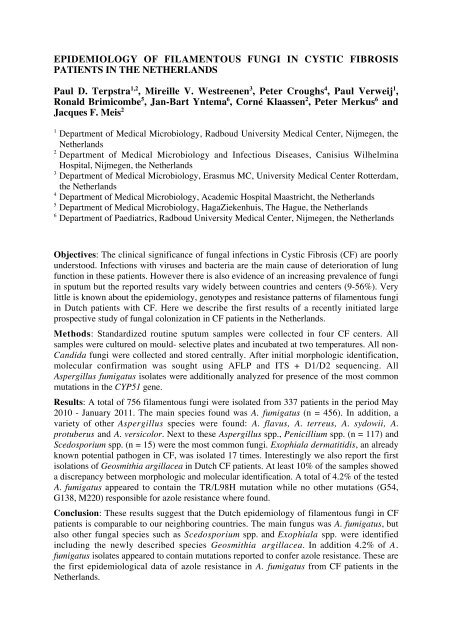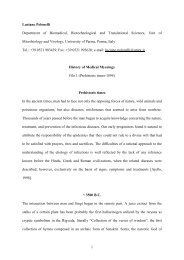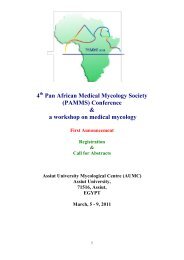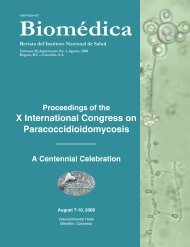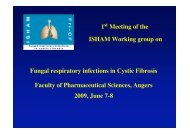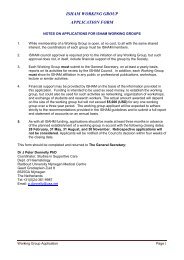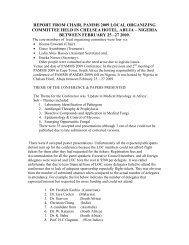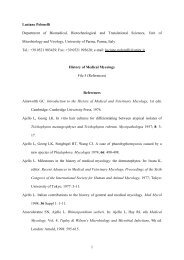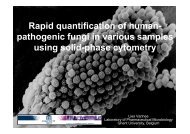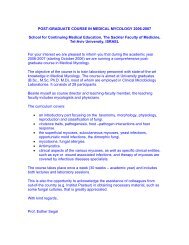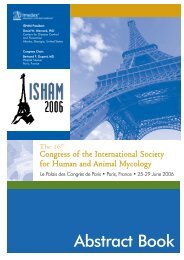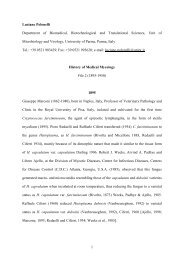Abstract book 2011 - ISHAM
Abstract book 2011 - ISHAM
Abstract book 2011 - ISHAM
Create successful ePaper yourself
Turn your PDF publications into a flip-book with our unique Google optimized e-Paper software.
EPIDEMIOLOGY OF FILAMENTOUS FUNGI IN CYSTIC FIBROSISPATIENTS IN THE NETHERLANDSPaul D. Terpstra 1,2 , Mireille V. Westreenen 3 , Peter Croughs 4 , Paul Verweij 1 ,Ronald Brimicombe 5 , Jan-Bart Yntema 6 , Corné Klaassen 2 , Peter Merkus 6 andJacques F. Meis 21 Department of Medical Microbiology, Radboud University Medical Center, Nijmegen, theNetherlands2 Department of Medical Microbiology and Infectious Diseases, Canisius WilhelminaHospital, Nijmegen, the Netherlands3 Department of Medical Microbiology, Erasmus MC, University Medical Center Rotterdam,the Netherlands4 Department of Medical Microbiology, Academic Hospital Maastricht, the Netherlands5 Department of Medical Microbiology, HagaZiekenhuis, The Hague, the Netherlands6 Department of Paediatrics, Radboud University Medical Center, Nijmegen, the NetherlandsObjectives: The clinical significance of fungal infections in Cystic Fibrosis (CF) are poorlyunderstood. Infections with viruses and bacteria are the main cause of deterioration of lungfunction in these patients. However there is also evidence of an increasing prevalence of fungiin sputum but the reported results vary widely between countries and centers (9-56%). Verylittle is known about the epidemiology, genotypes and resistance patterns of filamentous fungiin Dutch patients with CF. Here we describe the first results of a recently initiated largeprospective study of fungal colonization in CF patients in the Netherlands.Methods: Standardized routine sputum samples were collected in four CF centers. Allsamples were cultured on mould- selective plates and incubated at two temperatures. All non-Candida fungi were collected and stored centrally. After initial morphologic identification,molecular confirmation was sought using AFLP and ITS + D1/D2 sequencing. AllAspergillus fumigatus isolates were additionally analyzed for presence of the most commonmutations in the CYP51 gene.Results: A total of 756 filamentous fungi were isolated from 337 patients in the period May2010 - January <strong>2011</strong>. The main species found was A. fumigatus (n = 456). In addition, avariety of other Aspergillus species were found: A. flavus, A. terreus, A. sydowii, A.protuberus and A. versicolor. Next to these Aspergillus spp., Penicillium spp. (n = 117) andScedosporium spp. (n = 15) were the most common fungi. Exophiala dermatitidis, an alreadyknown potential pathogen in CF, was isolated 17 times. Interestingly we also report the firstisolations of Geosmithia argillacea in Dutch CF patients. At least 10% of the samples showeda discrepancy between morphologic and molecular identification. A total of 4.2% of the testedA. fumigatus appeared to contain the TR/L98H mutation while no other mutations (G54,G138, M220) responsible for azole resistance where found.Conclusion: These results suggest that the Dutch epidemiology of filamentous fungi in CFpatients is comparable to our neighboring countries. The main fungus was A. fumigatus, butalso other fungal species such as Scedosporium spp. and Exophiala spp. were identifiedincluding the newly described species Geosmithia argillacea. In addition 4.2% of A.fumigatus isolates appeared to contain mutations reported to confer azole resistance. These arethe first epidemiological data of azole resistance in A. fumigatus from CF patients in theNetherlands.


